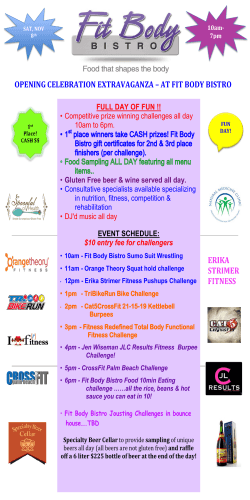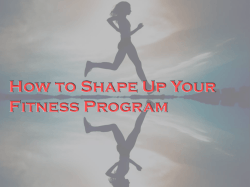
“Common Core & Physical Education” (What is the Connection?)
Mr. Tomaszewski W-F Elementary Physical Education “Common Core & Physical Education” (What is the Connection?) Why should PE be involved? Support the work of the core subject areas. Helps students formulate meaningful, appropriate experiences. Bridge student learning in Physical Education to what they are doing in the classroom. Cross-curricular connections can make learning relevant and meaningful to students. PE and ELA connections can help students develop both literacy and physical competence. Physical educators can integrate and build connections to literacy without compromising the goals of PE. As a PE Teacher I am encouraged to: Become familiar with Common Core State Standards Make intentional connections using Physical Education content Select formats consistent with classroom Collaborate with teachers in other curricular areas Allow students to interact with instructional text in Physical Education Incorporate academic language Learn from the effort of others WHAT IS MY ROLE? But How? By providing opportunity to: Use age appropriate vocabulary words Reinforce positive learning skills Ask and answer questions To speak in class Use written material that support fitness concepts Write in class Encourage literacy at home Implement a variety of strategies Mr. Tomaszewski W-F Elementary Physical Education “Common Core & Physical Education” (What is the Connection?) (INTEGRATION) STRATEGIES Language Arts Station cards Bulletin boards Dry erase boards Post verbal cues for skills Create handouts for students to read while waiting in line Write multiple step directions for students to follow Post informational text about the sport or skill Create a class web or blog (INTEGRATION) STRATEGIES Writing Written or peer evaluations related to movement activities Goal setting activities with the use of pedometers, heart rate monitors or fitness tests as a measure of goal attainment Rules and directions for a new game Describe a routine for dance or tumbling Developing educational brochures on the importance of physical activity Writing out a home fitness project (INTEGRATION) STRATEGIES Literacy Think pair share Sort sequence skill progression Demonstrate creative movement View pictures of skill development View videos to analyze skill Math Graph results of assessments Measure distance in non-traditional ways Skip counting Number line for scoring Use pedometers Explain rules of a game Sort equipment Mr. Tomaszewski W-F Elementary Physical Education “Common Core & Physical Education” (What is the Connection?) (INTERMEDIATE) STRATEGIES Literacy Explain cause and effect of the science of sport Identify parts of a movement sequence Design an offensive play and explain steps Create a plan for how to improve an area of fitness Write directions for skill or task Use digital media to develop picture sequence of skill (INTERMEDIATE) STRATEGIES Math Graph results of assessments Estimation (pedometer, distance) Set and track personal fitness goals Analyze pedometer data Create a rhythmic routine Record heart rate and calculate averages (SECONDARY) STRATEGIES Literacy Construct an argument to support an PE issue Write directions for a skill progression appropriate for peers Compose a response to a prompt Reflect on life experience related to PE Create a basic warm-up routine Locate routes for exercise and reflect difficulty of course Keep a journal to reflect on fitness progress (SECONDARY) STRATEGIES Math Evaluate levels of fitness with heart monitors Analyze data on current topics to identify problems in community Compare/Contrast level of participation with calorie expenditure Analyze fitness log information Change intensity of an exercise through problem solving Identify non-traditional materials to achieve a workout Mr. Tomaszewski W-F Elementary Physical Education “Common Core & Physical Education” (What is the Connection?) EVIDENCE Categorizing Mini Lessons Compare & Contrast Public Speaking Cooperative Learning Peer Partner Learning Decision-making Process Problem Solving Demonstrations Read Aloud Discussions Research Projects Drill & Practice Response Journal Essays Running Record Persuasive Writing Scaffolding Jigsaw Self Monitoring Strategies Journal Writing Surveys Learning Logs Think, Pair, Share Listen & Visualize REDUCING STRESS Collaborate Don’t change what you have been doing Teachers are already addressing many of the reading literature, reading for informational text, and listening and speaking standards Need to assess current curriculum There may not be a connection in every activity No need to use class time for “talking” as a substitute for activity, but instead integrate literacy skills.
© Copyright 2026





















